Articles of 2006
One-Punch Knockouts

Countless fans and more than a few writers often have been looking elsewhere when what is the most dramatic moment in boxing occurred – a one-punch knockout. It is a punch that not only puts an exclamation point to a fight, but also to the story surrounding the fight. After 12 rounds of his challenge to heavyweight champion Jersey Joe Walcott on Sept. 23, 1952, in Municipal Stadium at Philadelphia, unbeaten Rocky Marciano needed a knockout to win.
THE SCENE (13th round) – Not much is happening when Marciano backs Walcott to the ropes. Both fighters start throw right hands. Before Walcott's can land Marciano's crashes against the champion's jaw. Walcott slumps to the canvas, with one arm draped over a rope, where he is counted out. A count is not necessary.
“Marciano beat Walcott to the punch,” Jesse Abramson wrote in the New York Herald-Tribune. “It was a simple as that.” A.J. Liebling, in the New Yorker, called the punch “a model of pugilistic concision.” After 12 rounds, referee Charlie Daggert had it 7-4-1, Judge Zach Clayton saw it 8-4, and judge Pete Tomasco had it 7-5, all for Walcott. That meant that if Marciano had won the last three rounds, Daggert would have scored the fight a draw at 7-7-1, Clayton would have favored Walcott 8-7 and Tomasco would have had Marciano winning 8-7. Walcott would have kept the title on a draw.
* * *
Gene Fullmer could not believe what was he was seeing when he looked at Sugar Ray Robinson's corner before the sixth round of their middleweight title fight in Chicago Stadium on May 1, 1957.
Many years later he recalled the scene: “Robinson was in the corner jumping up and down, and I thought he's in marvelous condition. How come he's doing exercises between rounds?” Robinson was celebrating, not exercising.
THE SCENE (fifth round) – Fullmer opens the round with some lefts to the body. They exchange short punches inside, then clinch. There are some boos when Fullmer hits Robinson as they break from a clinch. Robinson fires several jabs to the head. Fullmer lunges toward Robinson and gets caught with a left hook to the jaw that drops him for the 10-count.
“His jaw looked a big as any of the jaws on the Mount Rushmore monuments,” Robinson said in “Sugar Ray”, his 1970 autobiography written with Dave Anderson.
It was the fourth time Robinson, a 3-1 underdog, won the middleweight championship. He had lost it to Fullmer on a decision four months earlier.
* * *
The left hook made Jersey Joe Walcott the oldest heavyweight champion at that time. It enabled Floyd Patterson to become the first man to regain the heavyweight title. It made Mike Tyson the youngest heavyweight champ.
Ezzard Charles' title defense against Walcott on July 18, 1951, at Forbes Field in Pittsburgh was called the “Why Fight.” Why was it being held? The 37-year-old Jersey Joe had already failed to win the heavyweight title four times – losing a controversial decision to Joe Louis, getting knocked out by Louis and losing two decisions to Charles.
THE SCENE (seventh round) – The two men are sparring when Walcott, a 6-1 underdog, crashes left hook to the jaw. The crowd of 28,282 – many people having troubling believing what just happened – roars to its feet as Charles falls face down, his gloved fists under him. He struggles to his knees as the count reaches 10. Walcott, overcome with emotion, drops to his knees. He tries to talk into a radio microphone, but he is speechless.
Charles was not speechless, but he surely was befuddled. “It was a sucker punch,” the ex-champion said in his dressing room. “Why I ever got in the way of it I'll never know.”
* * *
“When I hit him square with my right, the referee can count a thousand,” a confident Ingemar Johansson told the boxing world from his training camp a week before his first heavyweight title defense in a rematch against Floyd Patterson on June 10, 1960 at New York's Polo Grounds. In winning the title, Johansson had hit Patterson with that right to the tune of seven knockdowns in the third round. Patterson, however, was on his feet when the fight was stopped.
THE SCENE (fifth round) – Patterson fires a series of lefts to the head, and when Johansson drives right to the body the challenger counters with a left hook that drops the Swede. Johansson gets up at nine, bleeding from the mouth. Patterson momentarily measures his opponent before letting fly with a hook to the head. Johansson goes down on his back, his left foot quivering violently. Before referee Arthur Mercante can reach the count of 10 Patterson starts jumping in joy.
“It landed squarely on his jaw, and his head snapped to the left from the force of the blow,” Patterson said in “Victory Over Myself,” his 1962 autobiography, written with Milton Gross. “He went over backward, his feet flying in the air. I knew I was champion of the world again, right then.”
Mercante might not have been able to count to 1,000, but he could have counted a long way past 10.
* * *
With a combination of quickness, power and intimidation, Mike Tyson had needed only 77 rounds to win all 27 of his fights, 25 by knockouts, going into his challenge to WBC heavyweight champion Trevor Berbick on Nov. 18, 1986, at the Las Vegas Hilton. “If he attacks me, he's going to attack a wall,” Berbick said before the fight.
THE SCENE (second rounds) – Tyson lands a hard right to the head early in the round. Moments later he knocks down Berbick with another right to the head. Berbick springs up immediately and takes mandatory eight-count. Tyson attacks, landing a left and right to the head. After a clinch Tyson throws a right to the body. Berbick lands two jabs. Tyson lands several hard shots to the head. Berbick is hurt, but Tyson is showing patience. Tyson lands a jab and a right to the body. He misses a right uppercut, then knocks down Berbick with a left hook to the head. Berbick gets up, but falls back. He arises again, but falls forward. Up for the third time, but on wobbly legs, he is held up by referee Mills Lane, and the fight is over.
“I'm the champion of the world,” said Tyson, who at 20 years, 4 months and 22 days becomes youngest man ever to win the heavyweight title. “I refuse to get hurt, to lose. They will have to carry me out.”
* * *
When Roy Jones Jr. became the first man to have held the middleweight title to win the heavyweight championship he did something the legendary Stanley Ketchel could not accomplish. Their situations, however, were very different. Jones challenged John Ruiz, while Ketchel challenged Jack Johnson.
Just what happened, and why, on Oct. 16, 1909, at the Mission Street Arena in Colma, Calif., is subject to interpretation.
THE SCENE (10th round) – Ketchel throws a right at Johnson's head. Johnson ducks, and the blow lands behind his ear. He stumbles and falls. Apparently dazed Johnson rises at the count of two, then leaps toward Ketchel and throws a tremendous right that knocks the middleweight champion on to his back for the 10-count. The force of the blow carries Johnson forward, and he stumbles over Ketchel's legs, falling full length.
According to the New York Times account of the fight: “His right fist shot to the white man's jaw. His left crashed to the stomach, and the right swung again with the speed of lightning, catching Ketchel's head as he reeled back from the onslaught.” The grainy film of the fight, however, shows that the knockout was due to a single smashing right to head.
In “In the Ring and Out,” his autobiography first published in 1927, Johnson wrote, “Ketchel rushed me with determination to put me out. I met him with a murderous blow that put him out instead.” The film clearly shows Johnson leaping at Ketchel. Johnson also claimed in his autobiography that the knockout blow was an uppercut, although it looks like an overhand right on the film.
Shortly after the fight, Ketchel said, “I am in better condition that Johnson now. Look at him, he is dazed. But for one blow I would have beaten him.” Better condition? Ketchel had teeth knocked out. Johnson said he found a tooth embedded in his right glove. Nat Fleischer wrote in “The Michigan Assassin,” published in 1946, that two of Ketchel's teeth were found in Johnson's glove.
Johnson, who outweighed Ketchel 205½ to 170 ¼, contended in his autobiography that the fight lasted as long as it did because he wanted to “make the pictures (movies) snappy and worth seeing.” He admitted Ketchel's blow was a hard one, but that he saw a chance to give the fight a good ending “so I hit the canvas. All the time I was watching Ketchel and the referee. I was watching the latter so he would not count me out, and I was watching Ketchel so that he would be in the position I wished when I arose. . . .As I got to my feet I pretended to be groggy, but in reality I was ready to deliver the knockout.”
* * *
While Marciano's one-punch victory over Walcott is legendary, another one-punch KO in a heavyweight title fight has all been forgotten. It was scored by challenger Primo Carnera over Jack Sharkey, and some boxing historians and fans doubt its legitimacy because of Carnera's reputation as a manufactured fighter whose career was choreographed. The New York Times front-page story of the fight on June 29, 1933, at Madison Square Garden Bowl, however, called the punch “a terrific right hand uppercut to the chin which almost decapitated Sharkey and brought Carnera the title.” That was a little strong, but film of the punch showed it to be a legitimate knockout blow.
THE SCENE (sixth round) – At the bell, Carnera charges Sharkey, who has had much the best of the first five rounds, throwing lefts and rights and mauling the defending champion. Sharkey retreats to the ropes, and as Carnera moves in they clinch. Carnera throws a right, and Sharkey goes down, but he bounds up without a count. Carnera resumes his attack, and Sharkey fights back. Sharkey backs to the ropes, where the 6-foot-5½ Carnera throws a right uppercut with all of his 260½ pounds behind it. The 6-foot, 201-pound Sharkey drops face down and remains motionless as he counted out.
“Primo Carnera, regarded up to yesterday as a joke of nature or, at best, a fairground booth attraction, has become world champion thanks to a right uppercut in which there seemed to be concentrated the entire strength of all forty-three million Italians,” said the New York American. “He will become one of the most popular sovereigns of the ring in the annals of boxing.” the New York Journal predicted.
Carrnera's reputation, however, remains that of a joke to many followers of boxing because the outcomes of some of his earlier fights almost certainly were arranged, the trouncings he got from Max Baer and Joe Louis, and by the movie “The Harder They Fall,” clearly based on his life. But the right uppercut that made him a champion was anything but a laughing matter.
* * *
As Al Singer was riding home to the Bronx in a taxi after his fight against Tony Canzoneri on Nov. 14, 1930, in Madison Square Garden, he could not have been blamed for thinking, “Easy come, easy go.” It had been Singer's first defense of the lightweight title he had won by knocking out Sammy Mandell in 1:46.
THE SCENE (first round) – Nothing happens until Singer lands a left hook and right to the head, then shoots a left-right to the body before they clinch. Canzoneri lands a right to the body and hooks a left to the jaw that shakes Singer. The champion unleashes a wild flurry. Canzoneri crouches and throws some lefts and rights to the head. As Singer staggers Canzoneri comes out of his crouch with a left hook to the mouth that puts Singer flat on his face where he becomes a former champion in just 1:06.
The defeat meant Singer, a 3-1 favorite over Canzoneri, won and lost the lightweight championship in a total of 2:52. He hardly had time to break a sweat in either fight.
* * *
Hasim Rahman showed up a month before his challenge to WBC heavyweight champion Lennox Lewis on April 22, 2001, at Carnival City in Brakpan, South Africa. Lewis, involved in filming the remake of “Oceans Eleven” at Las Vegas in which he had a bit part, arrived in South Africa about a week before the fight..
THE SCENE (fifth round) – Lewis, who won three of the first four rounds on all three official cards, is controlling the action with his left jab until 1:25 into the round when Rahman jars him with a right to the head. Lewis answers with a jab, a right to the body and a left hook to the head. Rahman throws four straight jabs and forces Lewis to the ropes. Lewis starts to get off the ropes, then backs against them. Rahman crashes a right to the jaw between Lewis' upraised gloves. Lewis falls on his back, gets to a knee, but he cannot beat the count. Once he rises he is held up by his handlers.
“That should be rated R,” Rahman said after seeing a replay of a knockout punch. Lewis, who weighed 253½, the heaviest of his career up to that point and at 14½ pounds more than Rahman, denied he was overconfident. “This is what happens in heavyweight fights when you get hit you get hit with a shot; you don't beat the count they stop the fight,” he said in an HBO post-fight interview. It was pointed out to him that they stop fights in all weight classes if a fighter does not beat the count.
* * *
On Jan. 16, 1999, in the MGM Grand at Las Vegas, Mike Tyson fought Francois Botha in his first bout since he had his license revoked for biting Evander Holyfield's ears on June 28, 1997. After four rounds, Botha has won all of them on two official cards, and three of them on the third card. Trainer Tommy Brooks told Tyson to step it up. Tyson told Brooks to stay cool.
THE SCENE: (fifth round) – Both fighters land a few punches to the head and body, but they maul more than punch. Botha is talking to Tyson. With 40 seconds remaining, Tyson lands a stiff jab, and they exchange body shots. Botha lands a right the body and a right to the head. Botha starts a right to the body, and Tyson, perfectly balanced, crashes a right to Botha’s face. Botha falls as if struck by a hammer. Botha tries to get up, but he falls back. He struggles to a knee at the count of seven, then he falls back again, and referee Richard Steele waves the fight is over. There is one second left in the round.
“He was talking a lot of smack and stuff, but I was cool,” Tyson said. “Yeah, I was trying to bait him” Botha said. “I just walked into it.”
“I had a tremendous amount of ring rust,” Tyson said. “I just need to fight. I need to put on a better show.” The curtain, however, is lowering on the Mike Tyson show.
* * *
Sometimes a one-punch knockout is scored by a blow to the body. It is not as spectacular as KO punch to the head, but it can leave a fully conscious recipient writhing in pain, as Oscar De La Hoya did after being hit to the body by Bernard Hopkins. The most legendary body punch was the “solar plexus blow” Bob Fitzsimmons threw to knock out James J. Corbett and win the heavyweight title on March 17, 1897 at Carson City, Nev.
THE SCENE (14th round) – The two men mostly clinch in the first minute. Fitzsimmons feints a right to the head, Corbett leans back to avoid the punch, and Fitzsimmons rips a left that lands just under Corbett's heart and lifts the defending champion off his feet. As Corbett falls, he is hit by a right to the jaw. It is the body shot, however, that is the winning blow. His face a mask of agony, Corbett is counted out on left knee while grasping a rope with his right glove. There are some cries of “fix.” After Corbett is escorted to his corner he breaks away, shoves past people surrounding Fitzsimmons and throws a punch that is ducked by new champion. Corbett taps Fitzsimmons' ear, and Fitzsimmons smiles.
“That heart punch simply choked me up,” Corbett says in the New York Times account of the fight. “I could not breath or move for fifteen seconds, and it was several minutes before I realized that I had committed a breach of etiquette in trying to follow up my opponent after he put me out.”
Articles of 2006
Peter/Toney Ii: Peter Has The Brutal Punch

Samuel Peter claims he has dynamites in my two hands?
Heavyweight contenders Samuel “The Nigerian Nightmare” Peter and James Lights Out? Toney get it on a second time this Saturday from the Seminole Hard Rock in Hollywood, Fla. (Showtime).
The hard-slugging Peter, unlike Toney, is one of those strong, silent types notorious for letting their fists to the talking one the opening bell sounds, but the Nigeria Nightmare is as confident as ever and determined to turn Lights Out’s lights out for good.
I have got dynamites in my two hands,? said Peter, according the Lagos, Nigeria Vanguard, and I will crush James Toney once and for all. The Toney camp made the mistake of their lives by protesting and seeking a rematch. I am ready to teach him a bitter lesson.?
Sam Peter walked away with the W for Peter/Toney I at the Staples Center in LA last September, but it was by disputed split decision a verdict so disputed, there was even a dispute about the dispute which forced the WBC’s hand into mandating Saturday’s rematch.
Samuel Peter is the biggest thing to hit African boxing since Ghanaian superstar Azumah Nelson rocked the feather and junior welterweight divisions. The President of the Nigeria Boxing Board of Control, Prince Olaide Adeboye, admitted, according to allAfrica.com, We are rooting for Samuel Peter, of course. He is one boy we believe in to bring back the country’s lost glory in professional boxing. I am personally making arrangement to be at the ringside to see him fight Toney again. I was at the first fight in Los Angeles in September.
Peter has the brutal punch, and to me he was the clear winner of the first fight. But the WBC Board of Governors, of which I am a member, voted 21-10 for a rematch. There was nothing those of us Africans on the board could do in the circumstances. But I believe Peter will confirm he is better than Toney and will then go ahead to meet the champion and claim the belt for Nigeria and Africa.?
Articles of 2006
The Sweet Science P4P Rankings for Asia

There are claims that boxing is dying. Hogwash. The heavyweight division isn’t the only division in boxing and 2007 promises to be a banner year in boxing; especially for boxers hailing from Asia.
While Asia isn’t Vegas or Atlantic City, it is a region packed of diamonds in the rough; undiscovered gems and potential superstars who wait for their moment in the sun.
The Sweet Science P4P Rankings – Asia
1) Manny Pacquiao – There’s no way to dispute Pacquiao is the best fighter in Asia, if not all of boxing. He’s exciting, he wins with Je Ne Sais Quois and is definitely “the man” in boxing.
2) Pongsaklek Wonjongkam – Although his competition leaves much to be desired, his longevity and skills are undeniable. He is currently Thailand’s only world champion and is undefeated in ten years. Need I say more?
3) Chris John – A victory over Juan Manuel Marquez, however controversial, shows he belongs at the top of the heap. He easily outpointed Renan Acosta to close out 2006 and should have no trouble defending against Jose Rojas in February. A fight with Pacquiao would not be a good move on his part but a rematch with Marquez would not hurt – especially if he defeats the Mexican again.
4) Hozumi Hasegawa – Hidden away in Japan, Hasegawa is a sharp punching southpaw who put former champion Veeraphol Sahaprom to sleep. He recently bested Genaro Garcia and his herky-jerky style will give fits to any one who steps in the ring with him.
5) Masomori Tokuyama – Tokuyama has never shied away from a good fight and although he only fought once in 2006 (UD12 Jose Navarro), he ledger shows wins over Katsushige Kawashima (twice), Gerry Penalosa (twice) and In Jin Chi (twice). A fight with Hozumi Hasegawa is a distinct possibility in 2007.
6) Nobuo Nashiro – With only seven fights under his belt he took on WBA champion Martin Castillo – and defeated him. Although he’s only fought a total of nine fights, nearly all have been against quality opposition. A victory in a rematch with Castillo would cement his claim as the king of the 115-pound division.
7) Yukata Niida – This light-hitting minimumweight defended his title twice in 2006, winning a technical decision against unbeaten Eriberto Gejon (Tech Win 10) and the other on points over Ronald Barrera (W 12). Scheduled to meet Katsunari Takayama early next year – the best has yet to come for this WBA belt holder.
8) In Jin Chi – Won back the title he lost to Takashi Koshimoto in January from Rudolfo Lopez. While there’s little uncertainty to his skills, at thirty-three, 2007 may provide some insight as to just how much he has left.
9) Yodsanan Sor Nanthachai –Sor Nonthachai is an exciting, top-shelf fighter with an iron chin. Has no trouble making mincemeat of mid-level opposition and deserves a title shot in 2007. Time is running out.
10) Rey Bautista – He’s young, relatively inexperienced in big-time boxing, but will continue to shine in 2007. One of the better prospects in boxing, he should snag a title in 2007.
Asian Fighters Ranked in Ring Magazine
Pound for Pound:
Manny Pacquiao (Philippines): #2
Jr. Lightweight
Manny Pacquiao (Philippines): #1
Yodsanan Sor Nanthachai: #9
Featherweight
Chris John (Indonesia) #1
In Jin Chi (Korea) #3
Takashi Koshimoto (Japan) #5
Hioyuki Enoki (Japan) #7
Jr. Featherweight
Somsak Sithchatchawal (Thailand) #4
Bantamweight
Hozumi Hasegawa (Japan) #2
Veeraphol Sahaprom (Japan) #3
Ratanachai Sor Vorapin (Thailand) #6
Poonsawat Kratingdaenggym (Thailand) #10
Jr. Bantamweight
Nobuo Nashiro (Japan) #1
Katsushige Kawashima (Japan) #7
Pramuansak Phosuwan (Thailand) #10
Flyweight
Pongsaklek Wonjongkam (Thailand) #1
Takefumi Sakata (Japan) #7
Daisuke Naito (Japan) #10
Jr. Flyweight
Koki Kameda (Japan) #1
Minimumweight
Yukata Naiida (Japan) #2
Eagle Kyowa (Japan/Thai) #4
Katsunari Takayama (Japan) #5
Rodel Mayol (Philippines) #7
Boxing in Thailand
There’s no shortage of boxers in Thailand. With a huge pool of Muay Thai fighters to draw from and several talented amateur boxing prospects turning pro after the 2008 Beijing Olympics, Thailand seems destined to remain a boxing powerhouse in Asia.
The country is known for having tough, determined and disciplined fighters who give their all whenever the step in to the ring. However, consistently losing while fighting abroad and padding their records with no-hopers has done nothing to enhance their reputation.
Whether because of a lack of marketability, a lack of funds or their unwillingness to travel abroad, the vast majority of boxers from Thailand remain a mystery to fans in the west. If anything though, the boxing scene involving Thai fighters will be active. In fact, it’s one of the most active in the world; since 2000, the number of fights has nearly doubled in the country.
The Sweet Science P4P Rankings – Thailand – August 2006
1) Pongsaklek Wonjongkam
2) Poonsawat Kratingdaenggym
3) Somsak Sithchatchawal
4) Wandee Singwancha
5) Sirimongkol Singwancha
6) Yodsanan Sor Nanthachai
7) Veeraphol Sahaprom
8) Pramuansak Phosuwan
9) Terdsak Jandaeng
10) Oleydong Sithamerchai
Current Sweet Science P4P Rankings – Thailand
1) Pongsaklek Wonjongkam (Flyweight) – Definitely the top dog in Thailand
2) Yodsanan Sor Nanthachai (Super Lightweight) – He’s a seasoned fighter who has proven himself in the big-time. He’s one Thai who can fight outside of Asia. He has an abundance of skills and one-punch power. His overall ability and ease in dispatching anyone other than championship caliber get him the runners-up spot.
3) Poonsawat Kratingdaenggym (Super Bantamweight) – After losing to Vladimir Sidorenko he’s bounced back. He’s young, he can punch, but the former interim champion needs to prove himself against a name fighter.
4) Somsak Sithchatchawal (Super Bantamweight) – Was his win over Monshipour a fluke or was Celestino Caballero just that good? Did Sithchatchawal catch Monshipour at the right time and can he rebound from the devastating loss? The jury is still out.
5) Wandee Singwancha (Flyweight) – He doesn’t have much of a punch which will be his downfall in the end. He can box, as was evidenced in his recent victory over Juanito Rubillar, but this won’t be enough. He can no longer make the Jr. Flyweight limit and with no punch he’ll have a hard time competing against the “big boys.” Although he’s now rated second by the WBC, he doesn’t deserve to be.
5) Sirimongkol Singwancha (Super Lightweight) – Get this guy a fight. He’s better than Jose Armando Santa Cruz and would have beat up Inada had the fight taken place. He’ll fight anyone but his biggest obstacle is staying motivated fighting tomato cans in Thailand. Like many Thais, he needs a fight against a name opponent.
6) Wandee Singwancha (Flyweight) – He doesn’t have much of a punch which will be his downfall in the end. He can box, as was evidenced in his recent victory over Juanito Rubillar, but this won’t be enough. He can no longer make the Jr. Flyweight limit and with no punch he’ll have a hard time competing against the “big boys.” Although he’s now rated second by the WBC, he doesn’t deserve to be.
7) Pramuansak Phosuwan (Super Flyweight) – A genuine tough guy. Always calm and focused no matter how heated the battle. But at thirty-eight, he’ll be in trouble should he fight one of the division’s elite.
8) Veeraphol Sahaprom (Bantamweight) – Will be lucky to get another crack at the title. Although he has a puncher’s chance of winning a belt, that’s about all he has left at this point. A third shot at Hasegawa is unlikely.
9) Oleydong Sithamerchai (Minimumweight) – He’s fought better than the usual opponents faced by Thais at his level and he moves up one spot with the departure of Terdsak Jandaeng. He lacks the punch and is in the wrong division to become a superstar. He’ll need to defeat a name opponent to convince me.
10) Saenghiran Lookbanyai / Napapol Kittisakchokchai (Super Bantamweight) – These two square-off in early March, supposedly to see who deserves a shot at Israel Vasquez. Kittisakchokchai has the edge in experience but some feel Lookbanyai has the edge in heart and is the favorite.
Neither has defeated a top twenty fighter and yet are ranked number one and two respectively in the WBC’s world.
In Kittisakchokchoi’s lone shot at the big-time, he was TKO’d in 10 by Oscar Larios. His dreadful performance against Larios and lack of quality opposition leads me to believe Saenghiran might have more of a shot at beating him than some suspect. Regardless, neither of them lasts longer than six rounds with Israel Vasquez.
Honorable Mention: Wethya Sakmuangklang, Denkaosan Kaovichit, Devid Lookmahanak, Nethra Sasiprapa, Chonlatarn Piriyapinyo, Pornsawan Kratingdaenggym
Thai Fighters Ranked in Ring Magazine
Pongsaklek Wonjongkam: #1 Flyweight
Pramuansak Phosuwan: #10 Jr. Bantamweight
Veeraphol Sahaprom: #3 Bantamweight
Ratanachai Sor Vorapin: #6 Bantamweight
Poonsawat Kratingdaenggym: #10 Bantamweight
Somsak Sithchatchawal: #3 Jr. Featherweight
Yodsanan Sor Nanthachai: #9 Lightweight
Articles of 2006
Iceman Stops Tito Ortiz Win Streak

LAS VEGAS—UFC light heavyweight champion Chuck “Iceman” Liddell’s fists proved too much for Huntington Beach’s Tito Ortiz who was stopped in the third round before a sold out crowd at the MGM Garden Arena on Saturday.
The punching machine Liddell (20-3, 13 KOs) repeated his victory in UFC 66 over the much-improved grappler Ortiz who has improved his punching and blocking. Ortiz was trying to avenge his loss of April 2004.
Despite all the new weapons displayed by Ortiz it wasn’t enough as Liddell pummeled the former champion and retained his title with a technical knockout at 3:59 of the third round. Referee Mario Yamasaki stopped the bout.
“This was the most satisfying victory of my career,” said Liddell, 36, of Santa Barbara. “Tito came back real tough.”
Ortiz (15-5, 8 KOs), a former wrestler, worked on his boxing technique knowing he would need it against the former boxer Liddell. But Liddell’s experience allowed him to find the right moment to pounce on Ortiz.
“I had him hurt, I just kept throwing punches,” said Liddell who also knocked down Ortiz in the first round with a left hook.
Ortiz was gracious in defeat.
“Chuck is the best fighter Pound for Pound in the (mixed martial arts) world,” said Ortiz, 31, who suffered a gash on the side of his left eye from a punch. “I’m disgusted by myself. I let my fans down.”
Other bouts
Underdog Keith Jardine (12-3-1) knocked out Forrest Griffin (13-4) at 4:41 of the first round in their light heavyweight showdown. A right uppercut followed by a left hook wobbled Griffin who was sent to the floor by a barrage of punches. On the ground Jardine landed right after right until referee John McCarthy stopped the fight for a technical knockout.
“I couldn’t believe he was hurt,” said Jardine about Griffin who is known for his resiliency. “I was so nervous coming into this fight, but now I know I belong here.”
Canada’s Jason McDonald (18-7) choked out Chris Leben (15-3) in a middleweight bout that was up for grabs. Though Leben seemed to control the fight with stunning left hands, once the fight went to the ground McDonald managed a chokehold at 4:03 of the second round. Referee Steve Mazagatti saw Leben was unconscious and stopped the fight.
Former UFC heavyweight champion Andrei Arlovski (12-5) caught Brazil’s Mario Cruz (2-2) with a sneak right hand while both were tangled on the ground. Then the Belarusian pummeled Cruz until referee Herb Dean stopped the fight at 3:15 of the first round.
Third season winner of the Ultimate Fighter television reality season Michael Bisping (12-0) of Great Britain won by technical knockout over Eric Shafer (9-2-2) at 4:29 of the first round. A knee knocked Shafer groggy then Bisping knocked him to the ground and pounded him. Referee Mario Yamasaki stopped the bludgeoning.
Thiago Alves (16-4) caught Peru’s Tony De Souza (15-5) with a knee as he attempted to dive for his legs in a welterweight contest. After that it was pretty much over as Alves pummeled De Souza at 1:10 of the second round forcing referee John McCarthy to halt the bout.
Gabriel Gonzago (7-1) proved too strong for Carmelo Marrero (6-1) in a heavyweight bout. At 3:22 of the first round Gonzago of Massachusetts manipulated his way into arm bar forcing Pennsylvania’s Marrero to tap out.
Japan’s Yushin Okami (19-3) pounded Georgia’s Rory Singer (11-6) into submission at 4:03 of the third round of a middleweight bout. Okami seemed the more-rounded fighter with effective kicks to the head and more accurate punching.
Christian Wellisch (8-2) jumped to a quick start with an accurate left hook that rattled Australia’s Anthony Perosh (5-3) in a heavyweight bout. During the first round it seemed the Sacramento fighter might end the fight but the Aussie hung tough. Wellisch won by unanimous decision.
-
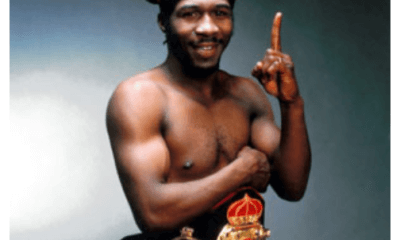
 Featured Articles4 weeks ago
Featured Articles4 weeks agoBoxing Odds and Ends: The Wacky and Sad World of Livingstone Bramble and More
-
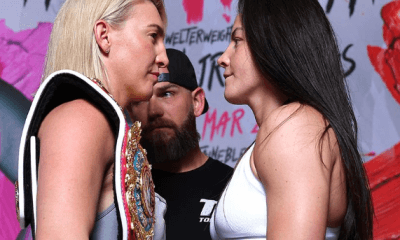
 Featured Articles4 weeks ago
Featured Articles4 weeks agoAvila Perspective, Chap. 319: Rematches in Las Vegas, Cancun and More
-

 Featured Articles4 weeks ago
Featured Articles4 weeks agoRingside at the Fontainebleau where Mikaela Mayer Won her Rematch with Sandy Ryan
-
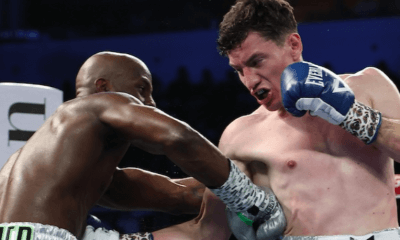
 Featured Articles4 weeks ago
Featured Articles4 weeks agoWilliam Zepeda Edges Past Tevin Farmer in Cancun; Improves to 34-0
-
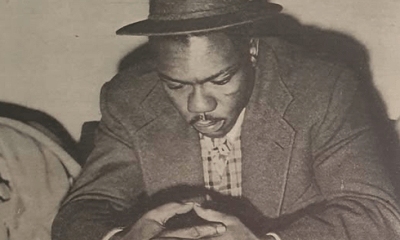
 Featured Articles3 weeks ago
Featured Articles3 weeks agoHistory has Shortchanged Freddie Dawson, One of the Best Boxers of his Era
-
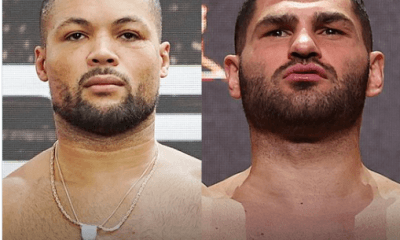
 Featured Articles3 weeks ago
Featured Articles3 weeks agoAvila Perspective, Chap. 320: Women’s Boxing Hall of Fame, Heavyweights and More
-
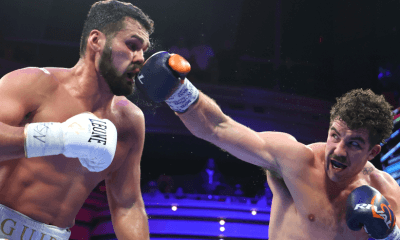
 Featured Articles3 weeks ago
Featured Articles3 weeks agoResults and Recaps from Las Vegas where Richard Torrez Jr Mauled Guido Vianello
-
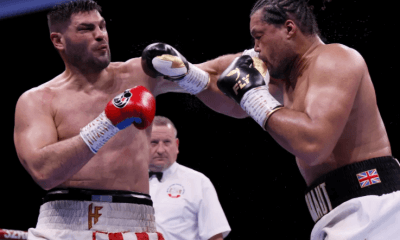
 Featured Articles3 weeks ago
Featured Articles3 weeks agoFilip Hrgovic Defeats Joe Joyce in Manchester















